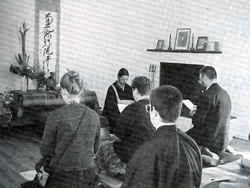It’s tough being a Buddhist in Alaska. Too much darkness, too much daylight, far too much cold. The cost of living is high, the economy is depressed—and so are many Alaskans: The state has one of the highest suicide rates in the country. So what could motivate a Buddhist priest to move halfway around the world to settle in a place that makes Tibet look tropical by comparison? In a word: love.

Rev. Yuho Van Parijs, serving as a minister at Jikoji, the Jodo Shinshu Pure Land temple in Antwerp, Belgium, found the task of setting up his temple’s website more rewarding than he ever imagined. While exchanging ideas with other Buddhists on the Internet, he met Diane Johnson, the woman who was to become his wife. Over several years, their cyber-romance blossomed, and in the summer of 1998 he moved to Anchorage.
From the beginning, their relationship was based not only on mutual respect and affection but also on a deep desire to spread the dharma. Thus was born the White Lotus Center for Shin Buddhism, Alaska’s first Pure Land temple. The pair wasted no time making their mark on Anchorage’s religious landscape. Diane set up a dharma school program for children of the temple. Yuho, who holds a master’s degree in comparative religion, began teaching undergraduate courses on Buddhist history at Alaska Pacific University. He also started offering ten-week adult education classes on Buddhism. “People want to hear about Buddhism, but they want to meet it on a more level ground,” Yuho notes. “They may be wary about visiting a temple.” The Van Parijses hit on a novel idea—why not hold a Change Your Mind Day in Alaska? The outdoor celebration of free Buddhist teachings, developed by Tricycle, had never been held outside of Manhattan’s Central Park. But Diane’s determination not only resulted in the spread of Change Your Mind Day (now held in as many as thirty-eight separate cities; see page 24) to Anchorage, it also brought about something nearly as surprising: Virtually all of the dozen or so Buddhist groups in Alaska participated, initiating an inter-Buddhist dialogue that had never before taken place in the Far North.
The White Lotus Center’s pansectarian efforts have continued, following the temple’s mission not only to spread Pure Land but to support all forms of Buddhism in Alaska. The temple allowed other Buddhist groups to use its space for meetings and services. Further outreach to the community occurred when Diane was elected President of the Anchorage Interfaith Council, and in her new position she persuaded representatives of the local Zen and Soka Gakkai groups to join the AIC, bringing a plurality of Buddhist voices into what had been a predominately Christian religious dialogue. The temple has made significant contributions to worldwide Buddhism, as well: In 2001 it created www.shinranworks.com to host the English translation of The Collected Works of Shinran. The thirteenth-century founder of Jodo Shinshu, Japan’s largest Buddhist sect, Shinran is one of the most important figures in the history of Buddhism, but prior to the White Lotus Center’s efforts his works were largely unavailable to the English-speaking world. “This is such a beautiful text, and so few people knew about it,” laments Yuho.
Running a temple in Alaska has proven much more challenging than in Belgium. “In Europe people want to study more. And people don’t move around so much. In Alaska people come and go constantly,” says Yuho. Though membership has gone up and down as people struggle with the difficulties of life on the last frontier, a diverse sangha has sprung up, with Caucasians, Taiwanese Americans, and Native Alaskans among its members. In February, Yuho officiated at the White Lotus Center’s first wedding, between two people who had met at the temple.
Another challenge results from the nature of Jodo Shinshu doctrine and practice itself. “The big difficulty is that Shin is a teaching that is very easily misunderstood,” says Yuho. Even he started out with doubts. “At first I had a lot of problems with Shin. The idea behind it seemed to reek of Christianity, which I was weary of. But over time I discovered there was much more to Pure Land Buddhism.” A further difficulty is that Shin’s rhetoric of “Come as you are” can be misinterpreted to mean “Anything goes.” Yuho also worries that Buddhism in America may sometimes be too sectarian. “These teachings are more universal,” he insists.
But in the face of these challenges, Yuho is determined to stay and make things work. Even his presence adds something important to Alaska’s Buddhist community. The only other ordained Buddhist teachers in the entire state are a handful of monks at the three Thai temples, and a priest at one of the Zen groups who plans to stay in Alaska for only a year or two. “Buddhist teachers come up here for visits and to give lectures, but they don’t stay,” Yuho notes. But with both love and dharma to keep it together, the White Lotus Center for Shin Buddhism is likely to remain a permanent outpost on Buddhism’s northern frontier.
Thank you for subscribing to Tricycle! As a nonprofit, we depend on readers like you to keep Buddhist teachings and practices widely available.